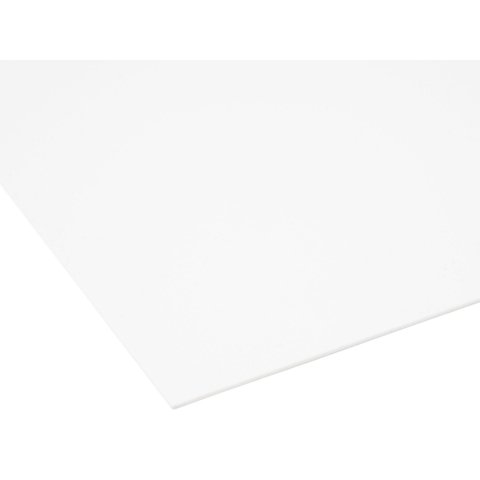| Location in Store | EGM55B |
|---|---|
| Article No. | 0320003 |
semi-gloss/semi-gloss, one side with protective film, flame resistant in compliance with DIN 4102 B1 (German Industry Norm)
The weather and moisture resistance of Forex boards make them ideal for outdoor use (e.g., signs, panel advertising, balcony parapets, wall panelling, etc.) and in the building of damp rooms. Because of their sturdiness at such a light weight, their ability to take print and their simple workmanship the boards can be found in use in trade shows and exhibition constructions, as backing for photos, in display and sign production or in the making of room dividers and furniture.
Forex foam boards should be cut using a carbide-tipped circular saw blade with teeth suitable for plastic work. The cutting speed should be up to 3000 m/minute depending on the density and tooth configuration of the saw blade; the feeder rate should be about 30 m/minute.
Metal drill bits and, when larger diameters are required, round hole cutters or centre bits can be utilized. The cutting speed should be between 50 and 300 rev/minute with a feeder rate from 0.3 – 0.5 mm/rev.
Forex foam boards can be painted, screen-printed and varnished. The best method for printing is the silkscreen process or the digital plate printing. Signs based on Forex are usually made with self-adhesive films like Oracal.
Forex sheets can be nailed, screwed, riveted and glued. When gluing is required the likewise named Cosmofen Plus HV Pvc Glue is the obvious choice. We will be more than glad to send you further information about working with Forex products.
Forex Classic is a lightweight closed cell PVC free foam sheet. It has an exceptionally fine and homogeneous cell structure and a satiny surface. The density of the plates is between 0,5g/cm³ - 0,7g/cm³
Despite their very light weight the sheets are extremely sturdy, impact resistant, lightfast, weather resistant, flame resistant and self-extinguishing (German construction classification B1 per DIN 4102). The sheets serve as great heat and cold as well as sound insulators. What we have on offer from Forex represents only a portion of their whole range of products.
Free standard delivery within Germany and free collection from Modulor in Berlin for orders over 89 €.
5,95 € shipping costs, if order value is less than 89 € (DE)
2,95 € for pick-up at the store in Berlin, if order value is less than 89 €
Express and forwarding shipping
From 19 € express surcharge you will receive your order particularly quickly with standard shipping within Germany.
From 69€ is the cost of shipping within Germany. You can recognize articles with forwarding shipping in the store by the truck symbol .
Especially for Berlin
From 34.90 € courier shipping for standard and forwarding goods.
- Free returns for standard shipping within Germany
- Extended, voluntary return policy of 30 days for complete, undamaged goods in their original packaging
- You are responsible for the cost of returns for forwarding goods and returns from a country outside Germany
Excluded from returns
Excluded from returns are sections of rolled goods, cut-to-size pieces and other goods made especially for you, as well as used goods, newspapers, magazines and periodicals, Modulor vouchers and items that we do not carry in our range but have ordered at your request.
Good to know: The furniture variants in our configurators that can be delivered quickly are not cut to size, but standard formats that can be returned.
